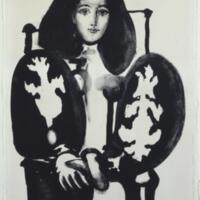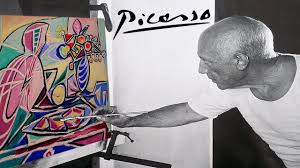Pablo Picasso is one of the most renowned and influential artists of the 20th Century and achieved fame and fortune during his lifetime. He is widely known as one of the co-founders of cubism, the co-invention collage, the inventor of the constructed sculpture, and helped develop and explore a variety of other styles. He explored a variety of art forms such as painting, ceramics, sculpture, printmaking, lithography, and stage design. His body of work is legendary, spanning more than 20,000 pieces and multiple styles, which makes it worth studying and displaying. As a person, Picasso was a pacifist, making numerous anti-war pieces such as Dove, and the universally acclaimed Guernica.
This website focuses on the lithography work made by Pablo Picasso between 1945 and 1949 in the atelier of Fernand Mourlot in Paris. While not his most recognizable style, it is still extremely interesting and has themes that are recurring in his artwork such as peace (Dove), and his lover (Woman in Armchair No. 1 (The Polish Cloak)). My personal interest in the life and art of Pablo Picasso led me to research more about his art for this midterm. My aim in this project was to learn more about this period of his work based on a dataset of the Tate Museum and create a digital exhibition of his work on Omeka, so more people can learn more about it too. For this project, I used many of the tools and methods taught in class such as data cleaning, the use of a public open-source dataset, and tools Omeka, and WordPress. My results are satisfactory as it is a nice-looking and easy-to-use website with useful information about Picasso's work.
Methodology:
I started this work by carefully analyzing all the datasets which were suggested in class, looking for what type of information each had, and brainstorming about what I could do as my project. My favorite dataset was by far the Tate Museum Artwork Dataset. So I cleaned it in Excel by removing the columns I thought were not important such as ID, artist id, artist role, credit line, acquisition date, among others. After that, I sorted the artists by name and looked for familiar ones. Upon seeing Pablo Picasso I thought about doing my midterm about his work, as I have always been interested in his life and art, but never had an opportunity to study him in depth. So I used the information from his pieces as the dataset for my project.
I proceeded by researching his biography and work on Wikipedia, Britannica, and the Pablo Picasso Website. What is more, I researched the following works using their respective pages on the Tate Museum website: Dove, Composition, Woman in an Armchair No. 1 (The Polish Cloak), and Head of a Young Boy.
The best approach to work with Picasso was by far a digital exhibition, as the dataset had metadata that is suitable for the Dublin Core of Omeka. Additionally, a website with standardized data fields is a good way to display his work in an intuitive, methodical way to further humanistic inquiry and research. Furthermore, websites are easy and intuitive to browse and even an average user could browse the website to learn more about Picasso.
I created an Omeka Webpage as the subdomain of my website for the course and proceeded to add the metadata of each art piece. I found a few challenges while doing that, many of the Dublin Core fields were not appropriate for my dataset. What is more, I was not exactly sure what to put on some of the fields I thought were important. However, I managed to figure it out. What is more, the dataset I was working on had enough information to fill out the metadata for each piece satisfactorily. For the description of each artwork, I used the information I collected about them on the Tate Museum website.
One potential pitfall of this approach is that I was working with pieces which do not have much information publicly available, only the Tate Museum had information for some of those. Therefore, I decided to use it as my source. However, if it had any inaccuracies or biases they might have been carried to my project.
Website:
For the website, I chose the Berlin template from Omeka, which looked minimalistic. This is appropriate, as I do not want the design choices of the website to compete with Picasso's artwork for the user's attention. The featured artwork is Dove, as it encompasses Picasso's pacifist nature and is one of the most important artworks of my exhibition (it was used to illustrate the poster of the 1949 Paris Peace Congress). The logo is the recognizable Picasso signature, which can properly characterize the nature of the website. The banner is a picture of Picasso working, which is appropriate as it shows the person behind each artwork (many users, myself included, might appreciate seeing that). A picture of the piece on display is in a prominent position on its own webpage, as it is the main thing users should pay attention to.
Significance:
This website is relevant as it summarizes a less documented period of Picasso's art, and shows it in an intuitive way to users. I focused on explaining about the meaning of each piece and giving context behind them in a way that users with little art background can understand. I also compiled a very brief introduction to Picasso and his life on the website. This way, students and people interested in art can learn more about Picasso and this period of his life. What is more, the website's metadata is on Dublin Core, which can be useful for further humanistic research (the other sources I found for the piece were not in Dublin Core), so this website can also be used by scholars researching Picasso. I believe this website contains both useful information about his work on the period and a nice looking interface, which will encourage users to learn more and appreciate his art. One pitfall is that there weren't abundant sources for my project, so a lot of the information comes from the Tate Museum website. So, I could not find different points of view and interpretations for each piece.
Featured Item
Original: La Colombe
Translation: Dove

This is a lithograph made by Picasso on 01/09/1949 in the atelier of Fernand Mourlot in Paris. It is a simple composition that, as the title suggests,…
Featured Collection
No featured collections are available.
Recently Added Items
Composition

"It took me four years to paint like Raphael, but a lifetime to paint like a child." - Pablo Picasso
Original: La Colombe
Translation: Dove

This is a lithograph made by Picasso on 01/09/1949 in the atelier of Fernand Mourlot in Paris. It is a simple composition that, as the title suggests,…
Original: Le Pichet noir et la tête de mort
Translation: Black Jug and Skull

This lithograph was made on 02/20/1946 and, as the title suggests, depicts a human skull and an open book on the table. It was made on the atelier of…
Original: Tête de jeune garçon
Translation: Head of a Young Boy

This is one of the earliest lithographs produced by Picasso in Mourlort's atelier in Paris. It has been interpreted as a nostalgic memory of himself…
Original: Femme au fauteuil No.1 (Le Manteau polonais)
Translation: Woman in an Armchair No.1 (The Polish Cloak)

The painting depicts Françoise Gilot, who was Picasso's companion in the 40s. As the title suggests, she is sitting on a chair while wearing a coat he…

